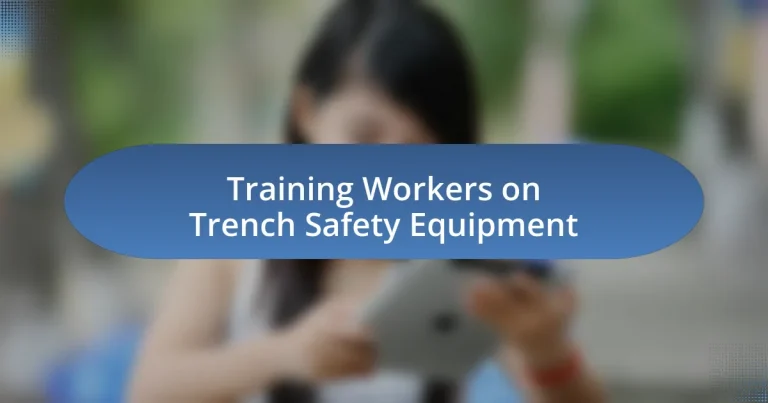Training workers on trench safety equipment is a critical process aimed at educating employees on the proper use and maintenance of safety equipment designed to protect them during trenching operations. This training is essential to prevent accidents, particularly cave-ins, which are a leading cause of fatalities in the construction industry. Key components of effective trench safety training include hazard recognition, the use of protective systems, safe work practices, and emergency response procedures. Compliance with regulations set by the Occupational Safety and Health Administration (OSHA) is mandatory, ensuring that workers are equipped with the necessary knowledge and skills to mitigate risks associated with trench work. The article further explores the types of trench safety equipment, effective training methods, and best practices for enhancing safety awareness among workers.

What is Training Workers on Trench Safety Equipment?
Training workers on trench safety equipment involves educating employees on the proper use and maintenance of equipment designed to protect them while working in or around trenches. This training is essential to prevent accidents and injuries associated with trench collapses, which can occur due to improper handling or lack of safety measures. According to the Occupational Safety and Health Administration (OSHA), proper training can significantly reduce the risk of fatalities and injuries in trenching operations, highlighting the importance of understanding equipment such as trench boxes, shoring systems, and personal protective gear.
Why is trench safety training essential for workers?
Trench safety training is essential for workers because it significantly reduces the risk of accidents and fatalities associated with trenching operations. According to the Occupational Safety and Health Administration (OSHA), trench collapses can occur within seconds, and they are among the leading causes of construction-related deaths. Proper training equips workers with knowledge about safe excavation practices, hazard recognition, and the use of protective equipment, which are critical for preventing injuries. Statistics show that effective training can lead to a 50% reduction in trench-related incidents, highlighting its importance in ensuring worker safety on job sites.
What are the risks associated with trench work?
The risks associated with trench work include cave-ins, falls, hazardous atmospheres, and equipment-related accidents. Cave-ins pose the most significant risk, as they can occur suddenly and lead to serious injuries or fatalities; according to the Occupational Safety and Health Administration (OSHA), approximately 75% of trench-related fatalities result from cave-ins. Falls into trenches can also occur, particularly if proper barriers or safety measures are not in place. Additionally, trenches may contain hazardous atmospheres, such as toxic gases or low oxygen levels, which can endanger workers’ health. Equipment-related accidents can happen when machinery is operated near trench edges, leading to collapses or injuries. These risks highlight the importance of proper training and safety equipment for workers engaged in trench work.
How can proper training mitigate these risks?
Proper training can mitigate risks associated with trench safety equipment by ensuring that workers are knowledgeable about safe practices and equipment usage. Training programs that cover hazard recognition, proper equipment handling, and emergency response procedures significantly reduce the likelihood of accidents. For instance, the Occupational Safety and Health Administration (OSHA) reports that effective training can decrease trench-related fatalities by up to 50%. By equipping workers with the necessary skills and awareness, proper training fosters a safer work environment and enhances compliance with safety regulations.
What are the key components of trench safety training?
The key components of trench safety training include hazard recognition, protective systems, safe work practices, and emergency response procedures. Hazard recognition involves identifying potential risks such as cave-ins, falling loads, and hazardous atmospheres. Protective systems, such as trench boxes and shoring, are essential for preventing collapses. Safe work practices encompass proper entry and exit procedures, as well as the use of personal protective equipment. Emergency response procedures ensure that workers know how to react in case of an incident, which is critical for minimizing injuries and fatalities. These components are vital for compliance with OSHA regulations, which mandate specific training requirements to ensure worker safety in trenching operations.
What types of trench safety equipment should workers be familiar with?
Workers should be familiar with several types of trench safety equipment, including trench boxes, shoring systems, and personal protective equipment (PPE). Trench boxes, also known as trench shields, are designed to protect workers from cave-ins by providing a safe space within the trench. Shoring systems, which can be hydraulic or mechanical, are used to support the walls of the trench and prevent collapses. Additionally, PPE such as hard hats, safety glasses, and high-visibility clothing is essential for protecting workers from potential hazards associated with trench work. The Occupational Safety and Health Administration (OSHA) emphasizes the importance of these safety measures, stating that proper equipment can significantly reduce the risk of injuries and fatalities in trenching operations.
How do workers learn to use trench safety equipment effectively?
Workers learn to use trench safety equipment effectively through structured training programs that include hands-on practice, demonstrations, and safety drills. These training programs are often mandated by regulatory agencies, such as the Occupational Safety and Health Administration (OSHA), which requires that workers receive proper instruction on the use of safety equipment to prevent accidents and injuries. Effective training incorporates real-life scenarios and simulations to enhance understanding and retention of safety protocols, ensuring that workers can apply their knowledge in actual trenching situations.
What regulations govern trench safety training?
The regulations that govern trench safety training are primarily outlined in the Occupational Safety and Health Administration (OSHA) standards, specifically 29 CFR Part 1926, Subpart P, which addresses excavation and trenching. These regulations mandate that employers provide training to workers on the hazards associated with trenching and excavation, including the proper use of protective systems. OSHA requires that this training be conducted by a qualified person and that it covers topics such as soil classification, hazard recognition, and the use of protective equipment. Compliance with these regulations is essential for ensuring worker safety in trenching operations.
Which organizations set the standards for trench safety training?
The organizations that set the standards for trench safety training include the Occupational Safety and Health Administration (OSHA) and the American National Standards Institute (ANSI). OSHA establishes regulations that govern trench safety practices to protect workers from hazards associated with trenching and excavation. ANSI develops consensus standards that provide guidelines for safe practices in various industries, including construction. These organizations ensure that safety training is aligned with legal requirements and industry best practices, thereby enhancing worker safety in trenching operations.
What are the legal requirements for trench safety training in the workplace?
The legal requirements for trench safety training in the workplace are primarily governed by the Occupational Safety and Health Administration (OSHA) regulations, specifically under 29 CFR 1926.650 to 1926.652. These regulations mandate that employers provide training to workers involved in excavation and trenching operations to recognize and avoid hazards associated with these activities.
Training must cover the proper use of protective systems, the identification of potential hazards such as cave-ins, and the safe operation of equipment. Additionally, employers are required to ensure that workers are trained by a qualified person who has the knowledge and experience to instruct on the specific hazards and safety measures related to trenching. Compliance with these regulations is essential to ensure worker safety and prevent accidents in trenching operations.
How can trench safety training be effectively implemented?
Trench safety training can be effectively implemented by incorporating hands-on training, regular assessments, and adherence to OSHA standards. Hands-on training allows workers to engage with trench safety equipment and procedures in real-world scenarios, enhancing their understanding and retention of safety practices. Regular assessments ensure that workers are knowledgeable about trench safety protocols and can identify hazards, which is crucial given that trench-related accidents account for approximately 100 fatalities annually in the United States, as reported by the Bureau of Labor Statistics. Adhering to OSHA standards, such as those outlined in 29 CFR 1926 Subpart P, provides a structured framework for training, ensuring that all safety measures are covered comprehensively.
What methods are most effective for delivering trench safety training?
The most effective methods for delivering trench safety training include hands-on training, interactive workshops, and the use of multimedia presentations. Hands-on training allows workers to practice safety procedures in a controlled environment, which has been shown to enhance retention of safety protocols. Interactive workshops encourage participation and discussion, fostering a deeper understanding of trench safety issues. Multimedia presentations, such as videos and simulations, can effectively illustrate potential hazards and safety measures, making the training more engaging and memorable. Research indicates that combining these methods can lead to improved safety outcomes, as workers are better prepared to recognize and respond to trench-related hazards.
How can employers assess the effectiveness of their trench safety training programs?
Employers can assess the effectiveness of their trench safety training programs by evaluating employee performance through practical assessments and monitoring compliance with safety protocols. This can include conducting regular safety drills, observing workers during trench operations, and reviewing incident reports to identify any safety breaches or near misses. Additionally, employers can utilize feedback surveys to gather insights from employees regarding their understanding of safety procedures and the training received. Research indicates that organizations implementing hands-on training and regular evaluations see a 30% reduction in trench-related accidents, highlighting the importance of continuous assessment in enhancing safety training effectiveness.
What are the common challenges in trench safety training?
Common challenges in trench safety training include inadequate understanding of safety protocols, lack of hands-on experience, and insufficient training resources. Workers often struggle to grasp the complexities of trench safety regulations, which can lead to non-compliance and increased risk of accidents. Additionally, many training programs do not provide practical, real-world scenarios, leaving workers unprepared for actual conditions. A study by the Occupational Safety and Health Administration (OSHA) indicates that improper training is a significant factor in trench-related fatalities, highlighting the need for comprehensive and effective training methods.
What obstacles do trainers face when educating workers on trench safety?
Trainers face several obstacles when educating workers on trench safety, including a lack of engagement from workers, insufficient understanding of safety protocols, and varying levels of experience among trainees. Workers often exhibit disengagement due to perceived irrelevance of the training, which can hinder their retention of critical safety information. Additionally, many workers may not fully grasp the complexities of trench safety protocols, leading to gaps in knowledge that can result in unsafe practices. Furthermore, the diverse experience levels among trainees can complicate the training process, as trainers must tailor their approach to accommodate both novice and experienced workers, making it challenging to ensure that all participants receive the necessary information effectively.
How can these challenges be overcome to ensure effective training?
To overcome challenges in training workers on trench safety equipment, organizations should implement hands-on training sessions combined with regular assessments. Hands-on training allows workers to engage directly with the equipment, enhancing their understanding and retention of safety protocols. Regular assessments ensure that workers are not only familiar with the equipment but also capable of applying safety measures effectively in real-world scenarios. Research indicates that experiential learning increases knowledge retention by up to 75%, compared to traditional lecture-based training methods.
What best practices should be followed in trench safety training?
Best practices in trench safety training include conducting thorough hazard assessments, ensuring proper use of protective systems, and providing comprehensive training on emergency procedures. Hazard assessments identify potential risks such as cave-ins, falling loads, and hazardous atmospheres, which are critical for worker safety. The use of protective systems, such as trench boxes or shoring, is essential to prevent collapses, as statistics show that cave-ins are a leading cause of fatalities in excavation work. Additionally, training workers on emergency procedures prepares them to respond effectively in case of an incident, enhancing overall safety. Regularly updating training materials and conducting refresher courses also contribute to maintaining high safety standards in trench operations.
How can ongoing training and refreshers improve trench safety awareness?
Ongoing training and refreshers significantly enhance trench safety awareness by ensuring that workers remain informed about the latest safety protocols and practices. Regular training sessions reinforce knowledge of hazards associated with trench work, such as cave-ins, and promote the use of protective measures like trench boxes and proper shoring techniques. Studies indicate that continuous education can reduce workplace accidents; for instance, the Occupational Safety and Health Administration (OSHA) reports that effective training programs can lead to a 30% decrease in incidents related to trenching. By keeping safety information current and relevant, ongoing training fosters a culture of safety, encouraging workers to prioritize safe practices consistently.
What resources are available for enhancing trench safety training programs?
Resources available for enhancing trench safety training programs include the Occupational Safety and Health Administration (OSHA) guidelines, which provide comprehensive standards for trench safety. Additionally, the National Utility Contractors Association (NUCA) offers training materials and certification programs specifically focused on trench safety. The American National Standards Institute (ANSI) also publishes safety standards that can be integrated into training programs. Furthermore, online platforms such as the National Safety Council provide e-learning courses that cover trench safety practices. These resources are validated by industry standards and are widely recognized for improving safety training effectiveness.
What practical tips can enhance trench safety training for workers?
Practical tips to enhance trench safety training for workers include conducting hands-on training sessions, utilizing visual aids, and implementing regular safety drills. Hands-on training allows workers to engage directly with trench safety equipment, fostering better understanding and retention of safety protocols. Visual aids, such as diagrams and videos, can clarify complex safety procedures and highlight potential hazards. Regular safety drills reinforce training by simulating emergency scenarios, ensuring workers are prepared to respond effectively. According to the Occupational Safety and Health Administration (OSHA), effective training can significantly reduce the risk of accidents in trenching operations, emphasizing the importance of these practical tips.

